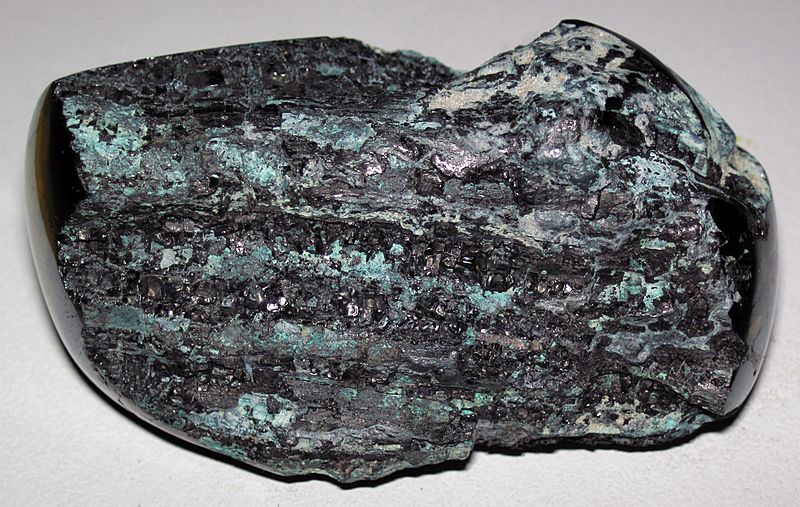Image: Chalcocite-permineralized fossil wood (Chinle Formation, Upper Triassic; Nacimiento Mine, southeast of Cuba, New Mexico, USA) (16981645718)

Description: Chalcocite-permineralized fossil wood from the Triassic of New Mexico, USA. Plants are multicellular, photosynthetic eucaryotes. The oldest known land plant body fossils are Silurian in age. Fossil root traces of land plants are known back in the Ordovician. The Devonian was the key time interval during which land plants flourished and Earth experienced its first “greening” of the land. The earliest land plants were small and simple and probably remained close to bodies of water. By the Late Devonian, land plants had evolved large, tree-sized bodies and the first-ever forests appeared. The fossil shown above is "petrified wood", which is a horrible term for what is technically called permineralization. Biogenic materials such as wood or bone have a fair amount of small-scale porosity. After burial, the porosity of wood or bone can get partially or completely filled up with minerals as groundwater or diagenetic fluids percolate through. The end result is a harder, denser material that retains the original three-dimensionality (or close to it). The wood or bone has become “petrified”. Well, no - it’s become permineralized. Not surprisingly, the most common permineralization mineral is quartz (SiO2). Sometimes, fossil wood and bone have been permineralized with radioactive minerals such as black uraninite (UO2) or yellowish carnotite (K2(UO2)2(VO4)2·3H2O). Recently, fossil bones permineralized with cinnabar have been identified (García-Alix et al., 2013, Lethaia 46: 1-6). This unusual specimen of fossil wood has been permineralized with black-colored chalcocite (Cu2S - copper sulfide). The greenish areas are malachite, the result of chalcocite alteration after being exposed at the surface. The Nacimiento Mine is developed at what appears to have been the boundary between oxidized and non-oxidized host rocks - in this case, Triassic sandstones. Chalcocite and other copper minerals have been highly enriched here. This type of concentration of economically valuable minerals is called supergene enrichment. Stratigraphy & host rock: sandstones of the Agua Zarca Member (correlative with the Shinarump Member), lower Chinle Formation, Upper Triassic Locality: Nacimiento Mine, southeast of the town of Cuba, western flanks of the Nacimiento Uplift, New Mexico, USA Most Nacimiento Mine geologic info. synthesized from: Tourtelot & Vine (1976) - Copper deposits in sedimentary and volcanogenic rocks, geology and resources of copper deposits. United States Geological Survey Professional Paper 907-C. 34 pp.
Title: Chalcocite-permineralized fossil wood (Chinle Formation, Upper Triassic; Nacimiento Mine, southeast of Cuba, New Mexico, USA) (16981645718)
Credit: Chalcocite-permineralized fossil wood (Chinle Formation, Upper Triassic; Nacimiento Mine, southeast of Cuba, New Mexico, USA)
Author: James St. John
Usage Terms: Creative Commons Attribution 2.0
License: CC BY 2.0
License Link: https://creativecommons.org/licenses/by/2.0
Attribution Required?: Yes
Image usage
The following page links to this image:

